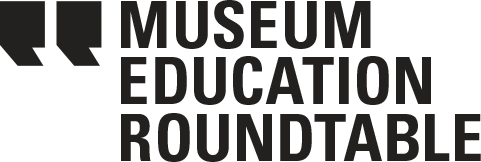Does Museum Education Have a Canon?
Recently I found myself in a series of intense meetings at the Wien Museum where I work, discussing the curation of a small, temporary exhibition culled from our permanent collection. Made necessary by a large special exhibition that will occupy the entire first floor of the museum, the gallery will showcase highlights from the museum’s seventeenth- and eighteenth- century collections, paring down an entire floor of some 600 objects to a mere 30. Curators and educators were all tasked with deciding which objects should stay and which should be put in storage. That educators should be invited to such a discussion represented a shift in a rather traditional museum culture, initiated by the new director.
Over the course of several months, we discussed what objects we considered central to our goals as a museum, to our public, and our team of educators, which is tasked with teaching over 700 school classes a year in our main building. We challenged ourselves to explain to each other exactly how each selected object fit into the narratives, engagements, and stories we wished to tell and engender. The seemingly tightly circumscribed goal of putting together a small show for six months slowly came to function as a memorandum on the museum’s decision-making process for object selection. In effect, the group had been asked to arbitrate and articulate the criteria for the museum’s canon.
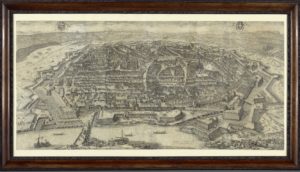
At one point, the group discussed a central issue in seventeenth-century Viennese history—the Second Ottoman Siege (in German the Osmanische Belagerung) and the resulting changes made to the city and its defensive walls. Two works stood at the center of our debate, only one of which could be accommodated in the smaller exhibition: Domenico Cetto’s View of Vienna from Josefstadt and Jacob Hoefnagel’s Bird’s Eye View of Vienna. How should we decide which of these works would be displayed and which put into storage? From an art historical point of view no controversy existed; art history long ago bestowed upon Hoefnagel’s print the status of an important work. A large-scale, complex copper etching and engraving on six plates, its value as a historical object is matched by Hoefnagel’s artistry. The Cetto painting on the other hand can only be described as somewhat lackluster in its execution.
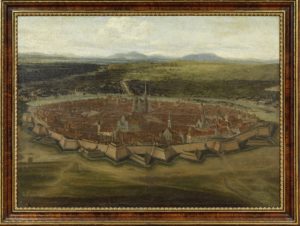
But for all of its artistic weakness, I argued forcefully for the Cetto painting, in large part because of the central role it plays in our school programming. Simply put, both works conveyed the same historical information that teachers expected educators to engage with, but the colorful painting succeeds in capturing the children’s attention much better than the monochrome print. At this point the museum faced a central question: with a stated mission of educating the public, a Lernort, should we choose the work that functioned better for the education department or the one that was art historically more significant, that is to say, traditionally canonical.
Early on in the course of these meetings I read Cynthia Robinson’s great recent blog post, which focuses on recognizing museum education’s expertise. In it she argues that in order for us to best advocate for educational goals in the museum, we must become fluent in our own theoretical and conceptual foundations. I was struck by the importance of this point throughout these conversations, because as the only educator in the room, my arguments had to hold up against a long tradition of art historical and historical valuations made about the works. I was up against years of art historical literature that defined the canon, advocating for an educational criteria for object selection within a group of people whose goals were not necessarily aligned with my own. How should I articulate why the Cetto, for all of its art historical weaknesses, was more important to engaging our target audience of school children than the large-scale prints? And how could I convince them that educational goals were in fact valid criteria for the decision we had to make?
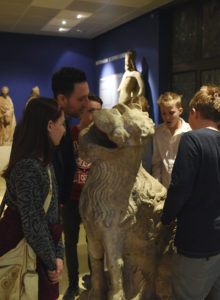 I am fortunate to work in a museum with curators who take our educational mandate seriously, and after some heated debate we decided that the arguments articulated by the education department regarding the needs and expectations of our public trumped those of the art historical values assigned to each work. But part of my ability to argue for the value of educational criteria for selecting works lay in this case in the museum’s historical character. The explicitly defined mandate of my museum–namely to educate the public about history–made the art historical judgments of the two works less central than the information they conveyed. Once I was able to articulate why the painting better communicated the same information than the print, I was in effect able to argue that the curators and I had aligned goals.
I am fortunate to work in a museum with curators who take our educational mandate seriously, and after some heated debate we decided that the arguments articulated by the education department regarding the needs and expectations of our public trumped those of the art historical values assigned to each work. But part of my ability to argue for the value of educational criteria for selecting works lay in this case in the museum’s historical character. The explicitly defined mandate of my museum–namely to educate the public about history–made the art historical judgments of the two works less central than the information they conveyed. Once I was able to articulate why the painting better communicated the same information than the print, I was in effect able to argue that the curators and I had aligned goals.
But what, I asked myself, if those priorities had not aligned? I wonder, for example, if I would have been so successful at the nearby Kunsthistorisches Museum? Is there room for multiple canons in a museum? If educators increasingly have a seat at the table in discussing not just programming but the exhibitions themselves, how do our judgements fit, overlap, conflict, and complement those of long-held traditions of the museum? How can we articulate our criteria for what makes a work worthy of inclusion, worthy of being placed with a canon? After all, with museum’s often displaying only a tiny portion of the works they hold, isn’t a permanent exhibition in part an argument for the importance of some works over others?
Canons are of course flexible, created to meet the needs of the stories that specific groups tell. Consequently, there is nothing ‘natural’ about objects that curators and the public (and educators!) value as canonical. When I think about canonical objects, my mind turns first to those objects from art history 101–works that remain central to the narratives of art and history that we tell. Valued for their innovation, their technique, and their historical significance among other determinants, their import remains largely, but not entirely, distinct from the needs of teaching in the gallery.
These canons are, of course, deeply biased in their focus on western art and exclusion of minorities and women, not to mention their obsession with painting at the expense of other art forms. But working in a history museum has made me increasingly aware of just how contingent the categories in which we place works (be they art or objects of everyday, natural history objects, etc) are. An object in my museum might be considered central, while in an art museum it might be relegated to storage. This has been for me a deeply empowering realization, even if it remains somewhat obvious. It means that if we as educators can shift the premises of the discussions in our museums from traditional criteria of academic canons to learning and teaching as our main goals, we can effectively argue for the display of objects that meet goals designed for our public and our investment in teaching and creating experiences with them.
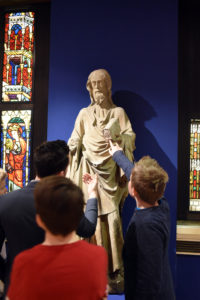 Certainly, the question of how we choose our objects to teach with intersects with much of the recent discussion about audience-centered engagement, and I see many overlaps with the points made in the wonderful post by Swarupa Anila. Canons can shift if we respond to what the public finds interesting, compelling, or important, as several articles in the “Does Museum Education Have a Canon?” issue of the Journal of Museum Education argued. But the public, itself influenced by the myths of western (art) history, often expects the traditional ‘canonical’ objects on a tour or in a program. And we as educators, as much as curators, bring expertise and knowledge that, while not more important than that of the public, is also worth honoring when deciding which objects are to play a central role in programming or exhibitions. Thus, while the role of the public in shaping the canon for teaching is of great value, and one that I do not in any way wish to diminish, I think that the question of whether museum education could define its own criteria for canonical objects has other implications as well. They might include questions and issues both pragmatic and more theoretical:
Certainly, the question of how we choose our objects to teach with intersects with much of the recent discussion about audience-centered engagement, and I see many overlaps with the points made in the wonderful post by Swarupa Anila. Canons can shift if we respond to what the public finds interesting, compelling, or important, as several articles in the “Does Museum Education Have a Canon?” issue of the Journal of Museum Education argued. But the public, itself influenced by the myths of western (art) history, often expects the traditional ‘canonical’ objects on a tour or in a program. And we as educators, as much as curators, bring expertise and knowledge that, while not more important than that of the public, is also worth honoring when deciding which objects are to play a central role in programming or exhibitions. Thus, while the role of the public in shaping the canon for teaching is of great value, and one that I do not in any way wish to diminish, I think that the question of whether museum education could define its own criteria for canonical objects has other implications as well. They might include questions and issues both pragmatic and more theoretical:
- Does the object fulfill the goals I need to achieve for my group? In the case of schools, does it offer the relevant topics or themes that school groups and their teachers expect and require of a museum visit? Can I articulate these learning goals clearly and concisely to a group of curators and the director? There is no reason that this should not be an equally valuable argument for a work’s inclusion than its value by academics.
- How do we as educators explain or think about the objects we choose to the public itself? How do we, for example, make clear why we avoid the Mona Lisa to a group that may well have expected to see it?
- How do our criteria intersect and overlap with those of curators, art historians, historians, and other museums professionals? Sometimes we find points of common value and use them to find bridges with our colleagues. By examining the overlaps, we may be better able to advocate for joint decisions in the museums and discover common ground with our colleagues.
- Canons are constructed subtlety, often with unidentified criteria. How can we as museum educators read and use curatorial literature critically, questioning the assumptions about what the major works in a show are? Once we are able to articulate the foundations of canonical arguments, we are better able to provide alternative narratives.
- Canons are multiple and created to support specific constructions of the world. How can educators argue effectively that our needs can just as easily justify an object’s inclusion?
The notion of the canon, once thought to be outdated, seem to me to be extremely useful for museum education. Canons help us organize the world, create criteria, value things against each other, and argue for relative importance in relation to specific goals. If multiple canons can exist, as many art historians and literary theorists have recently argued, then there is no reason to believe that museum education cannot itself create a canon, or criteria for thinking about canonicity for teaching to varied groups. It can shift, change, and be flexible but be just as theoretically and historically grounded as those of art history, literature, science, and history.
In the end, the actual creation of a canon for museum education may be impossible and ultimately not useful- each educator must work with the objects that his or her own museum has. But thinking about what criteria we use to argue for a work’s inclusion or to select works for our programs is a way of articulating our own criteria, goals, and processes as a discipline.
Nathaniel Prottas is the Director of Education and Visitor Services at the Wien Museum, Austria. He completed his PhD in art history at the University of Pennsylvania in 2014 and has held fellowships through the Fulbright Scholar Program, the Deutscher Akdemischer Austauschdienst, the Metropolitan Museum of Art and the Frick Collection, where he was the Samuel H, Kress Interpretive Fellow from 2013-14.
